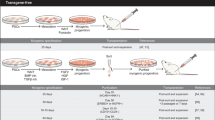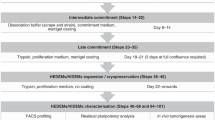Abstract
Muscle homeostasis is maintained by resident stem cells which, in both pathologic and non-pathologic conditions, are able to repair or generate new muscle fibers. Although muscle stem cells have tremendous regenerative potential, their application in cell therapy protocols is prevented by several restrictions, including the limited ability to grow ex vivo. Since pluripotent stem cells have the unique potential to both self-renew and expand almost indefinitely, they have become an attractive source of progenitors for regenerative medicine studies. Our lab has demonstrated that embryonic stem cell (ES)-derived myogenic progenitors retain the ability to repair existing muscle fibers and contribute to the pool of resident stem cells. Because of their relevance in both cell therapy and disease modeling, in this chapter we describe the protocol to derive myogenic progenitors from murine ES cells followed by their intramuscular delivery in a murine muscular dystrophy model.
Access this chapter
Tax calculation will be finalised at checkout
Purchases are for personal use only
Similar content being viewed by others
References
Collins CA, Olsen I, Zammit PS, Heslop L, Petrie A, Partridge TA, Morgan JE (2005) Stem cell function, self-renewal, and behavioral heterogeneity of cells from the adult muscle satellite cell niche. Cell 122(2):289–301. doi:10.1016/j.cell.2005.05.010, S0092-8674(05)00455-1 [pii]
Partridge TA, Morgan JE, Coulton GR, Hoffman EP, Kunkel LM (1989) Conversion of mdx myofibres from dystrophin-negative to -positive by injection of normal myoblasts. Nature 337(6203):176–179. doi:10.1038/337176a0
Sampaolesi M, Blot S, D’Antona G, Granger N, Tonlorenzi R, Innocenzi A, Mognol P, Thibaud JL, Galvez BG, Barthelemy I, Perani L, Mantero S, Guttinger M, Pansarasa O, Rinaldi C, Cusella De Angelis MG, Torrente Y, Bordignon C, Bottinelli R, Cossu G (2006) Mesoangioblast stem cells ameliorate muscle function in dystrophic dogs. Nature 444(7119):574–579. doi:10.1038/nature05282, nature05282 [pii]
Sampaolesi M, Torrente Y, Innocenzi A, Tonlorenzi R, D’Antona G, Pellegrino MA, Barresi R, Bresolin N, De Angelis MG, Campbell KP, Bottinelli R, Cossu G (2003) Cell therapy of alpha-sarcoglycan null dystrophic mice through intra-arterial delivery of mesoangioblasts. Science 301(5632):487–492. doi:10.1126/science.1082254, 1082254 [pii]
Tedesco FS, Hoshiya H, D’Antona G, Gerli MF, Messina G, Antonini S, Tonlorenzi R, Benedetti S, Berghella L, Torrente Y, Kazuki Y, Bottinelli R, Oshimura M, Cossu G (2011) Stem cell-mediated transfer of a human artificial chromosome ameliorates muscular dystrophy. Sci Transl Med 3(96):96ra78. doi:10.1126/scitranslmed.3002342, 3/96/96ra78 [pii]
Darabi R, Arpke RW, Irion S, Dimos JT, Grskovic M, Kyba M, Perlingeiro RC (2012) Human ES- and iPS-derived myogenic progenitors restore DYSTROPHIN and improve contractility upon transplantation in dystrophic mice. Cell Stem Cell 10(5):610–619. doi:10.1016/j.stem.2012.02.015, S1934-5909(12)00074-4 [pii]
Darabi R, Gehlbach K, Bachoo RM, Kamath S, Osawa M, Kamm KE, Kyba M, Perlingeiro RC (2008) Functional skeletal muscle regeneration from differentiating embryonic stem cells. Nat Med 14(2):134–143. doi:10.1038/nm1705, nm1705 [pii]
Darabi R, Pan W, Bosnakovski D, Baik J, Kyba M, Perlingeiro RC (2011) Functional myogenic engraftment from mouse iPS cells. Stem Cell Rev 7(4):948–957. doi:10.1007/s12015-011-9258-2
Tedesco FS, Gerli MF, Perani L, Benedetti S, Ungaro F, Cassano M, Antonini S, Tagliafico E, Artusi V, Longa E, Tonlorenzi R, Ragazzi M, Calderazzi G, Hoshiya H, Cappellari O, Mora M, Schoser B, Schneiderat P, Oshimura M, Bottinelli R, Sampaolesi M, Torrente Y, Broccoli V, Cossu G (2012) Transplantation of genetically corrected human iPSC-derived progenitors in mice with limb-girdle muscular dystrophy. Sci Transl Med 4(140):140ra189. doi:10.1126/scitranslmed.3003541, 4/140/140ra89 [pii]
Takahashi K, Tanabe K, Ohnuki M, Narita M, Ichisaka T, Tomoda K, Yamanaka S (2007) Induction of pluripotent stem cells from adult human fibroblasts by defined factors. Cell 131(5):861–872. doi:10.1016/j.cell.2007.11.019, S0092-8674(07)01471-7 [pii]
Takahashi K, Yamanaka S (2006) Induction of pluripotent stem cells from mouse embryonic and adult fibroblast cultures by defined factors. Cell 126(4):663–676. doi:10.1016/j.cell.2006.07.024, S0092-8674(06)00976-7 [pii]
Sterneckert JL, Reinhardt P, Scholer HR (2014) Investigating human disease using stem cell models. Nat Rev Genet 15(9):625–639. doi:10.1038/nrg3764, nrg3764 [pii]
Buckingham M, Relaix F (2007) The role of Pax genes in the development of tissues and organs: Pax3 and Pax7 regulate muscle progenitor cell functions. Annu Rev Cell Dev Biol 23:645–673. doi:10.1146/annurev.cellbio.23.090506.123438
Relaix F, Rocancourt D, Mansouri A, Buckingham M (2005) A Pax3/Pax7-dependent population of skeletal muscle progenitor cells. Nature 435(7044):948–953. doi:10.1038/nature03594, nature03594 [pii]
Iacovino M, Bosnakovski D, Fey H, Rux D, Bajwa G, Mahen E, Mitanoska A, Xu Z, Kyba M (2011) Inducible cassette exchange: a rapid and efficient system enabling conditional gene expression in embryonic stem and primary cells. Stem Cells 29(10):1580–1588
Kyba M, Perlingeiro RC, Daley GQ (2002) HoxB4 confers definitive lymphoid-myeloid engraftment potential on embryonic stem cell and yolk sac hematopoietic progenitors. Cell 109(1):29–37, S0092867402006803 [pii]
Darabi R, Santos FN, Filareto A, Pan W, Koene R, Rudnicki MA, Kyba M, Perlingeiro RC (2011) Assessment of the myogenic stem cell compartment following transplantation of Pax3/Pax7-induced embryonic stem cell-derived progenitors. Stem Cells 29(5):777–790. doi:10.1002/stem.625
Sakurai H, Era T, Jakt LM, Okada M, Nakai S, Nishikawa S (2006) In vitro modeling of paraxial and lateral mesoderm differentiation reveals early reversibility. Stem Cells 24(3):575–586. doi:10.1634/stemcells.2005-0256, 2005-0256 [pii]
Magli A, Schnettler E, Rinaldi F, Bremer P, Perlingeiro RC (2013) Functional dissection of Pax3 in paraxial mesoderm development and myogenesis. Stem Cells 31(1):59–70. doi:10.1002/stem.1254
Magli A, Schnettler E, Swanson SA, Borges L, Hoffman K, Stewart R, Thomson JA, Keirstead SA, Perlingeiro RC (2014) Pax3 and Tbx5 specify whether PDGFRalpha + cells assume skeletal or cardiac muscle fate in differentiating embryonic stem cells. Stem Cells 32(8):2072–2083. doi:10.1002/stem.1713
Quinlan JG, Lyden SP, Cambier DM, Johnson SR, Michaels SE, Denman DL (1995) Radiation inhibition of mdx mouse muscle regeneration: dose and age factors. Muscle Nerve 18(2):201–206. doi:10.1002/mus.880180209
Wakeford S, Watt DJ, Partridge TA (1991) X-irradiation improves mdx mouse muscle as a model of myofiber loss in DMD. Muscle Nerve 14(1):42–50. doi:10.1002/mus.880140108
Arpke RW, Darabi R, Mader TL, Zhang Y, Toyama A, Lonetree CL, Nash N, Lowe DA, Perlingeiro RC, Kyba M (2013) A new immuno-, dystrophin-deficient model, the NSG-mdx(4Cv) mouse, provides evidence for functional improvement following allogeneic satellite cell transplantation. Stem Cells 31(8):1611–1620. doi:10.1002/stem.1402
Couteaux R, Mira JC, d’Albis A (1988) Regeneration of muscles after cardiotoxin injury. I. Cytological aspects. Biol Cell 62(2):171–182, 0248-4900(88)90034-2 [pii]
Mahdy MA, Lei HY, Wakamatsu J, Hosaka YZ, Nishimura T (2015) Comparative study of muscle regeneration following cardiotoxin and glycerol injury. Ann Anat 202:18–27. doi:10.1016/j.aanat.2015.07.002, S0940-9602(15)00103-X [pii]
Harris JB (2003) Myotoxic phospholipases A2 and the regeneration of skeletal muscles. Toxicon 42(8):933–945. doi:10.1016/j.toxicon.2003.11.011, S0041010103003313 [pii]
Charge SB, Rudnicki MA (2004) Cellular and molecular regulation of muscle regeneration. Physiol Rev 84(1):209–238. doi:10.1152/physrev.00019.2003, 84/1/209 [pii]
Acknowledgements
The Perlingeiro laboratory is supported by grants from the NIH (R01 AR055299), the Muscular Dystrophy Association (MDA #238127) and Parent Project Muscular Dystrophy (PPMD #00031645). A.M. was funded by a fellowship from Regenerative Medicine Minnesota (MRM 2015 PDSCH 003).
Author information
Authors and Affiliations
Corresponding author
Editor information
Editors and Affiliations
Rights and permissions
Copyright information
© 2016 Springer Science+Business Media New York
About this protocol
Cite this protocol
Magli, A., Incitti, T., Perlingeiro, R.C.R. (2016). Myogenic Progenitors from Mouse Pluripotent Stem Cells for Muscle Regeneration. In: Kyba, M. (eds) Skeletal Muscle Regeneration in the Mouse. Methods in Molecular Biology, vol 1460. Springer, New York, NY. https://doi.org/10.1007/978-1-4939-3810-0_14
Download citation
DOI: https://doi.org/10.1007/978-1-4939-3810-0_14
Published:
Publisher Name: Springer, New York, NY
Print ISBN: 978-1-4939-3808-7
Online ISBN: 978-1-4939-3810-0
eBook Packages: Springer Protocols




